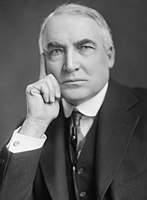| ||||||||||||||||||||||||||
| ||||||||||||||||||||||||||
 County Results
| ||||||||||||||||||||||||||
| ||||||||||||||||||||||||||
| Elections in Indiana |
|---|
 |
The 1920 United States presidential election in Indiana took place on November 2, 1920, as part of the 1920 United States presidential election which was held throughout all contemporary 48 states. Voters chose 15 representatives, or electors to the Electoral College, who voted for president and vice president.
Ever since the Civil War, partisan alliances in Indiana had been related to history of White settlement, with most of Southern Indiana and German-settled counties voting strongly Democratic, opposed to Yankee-settled Northern Indiana which voted Republican.[1] Between the end of the Civil War and the end of the Third Party System, elections in the state were always very close; although the state become more Republican when William Jennings Bryan’s free silver policy drove conservative Democrats to the Republican party for the following two decades.[2] However, only Alton B. Parker would lose the state by more than five percentage points as its strong Southern leanings meant its Democratic counties remained very loyal.[3]
After being won by Woodrow Wilson and running mate Thomas R. Marshall over divided Republican opposition in 1912, Indiana would be won narrowly by Republican Charles Evans Hughes of New York in 1916, this being the first time a losing candidate carried the state since 1876 and the first time since 1848 that a candidate losing the popular vote won the state.
In 1920, the isolationism of the Midwest and Wilson’s extreme unpopularity ensures that Indiana would clearly vote for the Republican nominee, Ohio Senator Warren G. Harding, over the Democratic nominee, Ohio Governor James M. Cox. Harding ran with Massachusetts Governor Calvin Coolidge, while Cox ran with Assistant Secretary of the Navy Franklin D. Roosevelt of New York.
Harding won the state by a margin of 14.65 percentage points; however, Indiana would be easily Cox’s best antebellum free state, voting 11.52 percentage points more Democratic than the nation at-large.
- ^ Phillips, Kevin P.; The Emerging Republican Majority, p. 343 ISBN 9780691163246
- ^ Phillips; The Emerging Republican Majority, p. 352
- ^ Menendez, Albert J. (2005). The Geography of Presidential Elections in the United States, 1868-2004. McFarland. p. 37. ISBN 0786422173.

